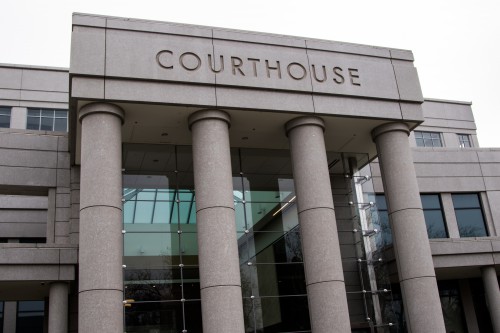

By Cynthia Hoang-Duong and CiCi Jiang
WOODLAND, CA – In a Yolo County Superior Court Dept. 9 jury trial this week, a man was found guilty of misdemeanor carrying a loaded firearm in a public place.
But the verdict only came after the prosecution and defense engaged in a tense argument regarding the definition of “public place” as the third element of the accused’s charge for carrying a loaded firearm.
On June 26, 2022, according to court testimony, West Sacramento Police Dept. officers arrived at a mobile home park after they were informed that the accused was carrying a loaded pistol in his truck. The officers identified the truck in the visitor parking spot of the property and found a loaded gun inside.
Thursday morning, the courtroom was about to proceed with the defense and prosecution’s closing arguments, but before the jury entered the courtroom, Deputy District Attorney Aaron Rojas and Deputy Public Defender Peter Borruso discussed with Judge Sonia Cortés jury instructions and stipulations she would give before their closing statements.
DDA Rojas refused to enter into a stipulation because of the ambiguity of the June 26 date, claiming CALCRIM No. 207 (jury instructions) allows the prosecution to not prove that the conduct occurred exactly on a day, only that it happened reasonably close to the alleged date—he maintained that because the accused’s conduct met the elements of the crime, it was the jury’s discretion to decide if it was sufficient to return a guilty verdict.
In response, the DPD raised concerns about fairness and due process issues because the complaint did not include a date range. The notice given to the accused was “on or about June 26” and Borruso questioned how his client would have been notified of his charges based on an abstract date.
The DPD requested the court restrict arguments to on or about June 26, asking how the defense could have a fair trial if they were not given notice of an incident until the morning of trial and closing arguments.
The DDA explained, “The court has made rulings previously not to restrict defense’s argument even though his reading of … a public place is … contrary to the law. I don’t think it’s fair that the court would restrict the People’s argument when it’s consistent with the law.”
The judge agreed with the DPD’s due process concerns that the defense could not have prepared for an incident that the accused was not notified of and thus, the DDA withdrew his request to apply the CALCRIM.
However, despite his withdrawal, Borruso expressed his distaste for his opposing counsel’s previous comments regarding his definitions of a public place.
“This is the second time it has happened in two days and I would like the court to admonish the prosecutor. I believe there has been prosecutorial misconduct twice in two days—making disparaging comments toward the defense counsel,” complained the DPD.
He noted the previous day, the DDA had argued the DPD was misleading the court, and Thursday morning, the DDA had claimed the DPD argument was contrary to the law.
“It is inappropriate to make that kind of comment. First of all, it’s a chilling effect in terms of my representation of my client. And second of all, it’s untrue,” said Borruso.
Rojas explained that it was not his intention to make disparaging comments and that he characterized the DPD’s argument as contrary to the law because Borruso’s definition was not consistent with the analysis of previous courts.
Judge Cortés mediated between the attorneys, stating that she did not believe either was attempting to mislead the jury before reminding them to treat each other with professional courtesy during their closing arguments.
However, DDA Rojas reiterated he would not object during the defense’s closing argument but maintained his continuing objection to how the defense framed the law in its argument.
Exasperated, Borruso argued, “At this point, are we getting into a chilling effect in terms of summation, closing argument? Mr. Rojas keeps bringing up, somehow trying to chill defense from making a closing argument about the elements of the crime.”
Because the court could not precisely predict the defense’s closing argument, Judge Cortés denied the continuing objection and concluded the discussion.
After the jurors arrived and the judge recited the jury instructions, DDA Rojas began his closing statement by reminding the jury of the three elements of the accused’s charge: [1] he was carrying a loaded firearm in a vehicle; [2] he knew he was carrying a firearm; and [3] the firearm was in a public place where it is unlawful to discharge.
Because the first two elements were clear, he focused on the third element, stressing that words have different legal meanings than everyday usage. Based on the CALCRIM instruction, “public place” can apply to private property if it is accessible to the public. Even if it had the right to exclude people, it is still accessible to delivery persons and solicitors and, thus, was a public place.
He presented bodycam still shots and the defense’s exhibit of the mobile home park with signs that allowed visitors to proceed into the units and highlighted common areas, claiming these were indicative of a public place.
In the defense’s closing statement, the DPD disagreed with Rojas’ definition of a public place, contending that because the property limited the space to residents, guests, and visitors, it did not constitute a public place. He argued, following the prosecution’s argument, a house would be accessible because anyone could break into it.
Further, he emphasized that the prosecution did not provide evidence of the nature of the property regarding its accessibility or counterevidence about its privacy and stressed the police officers’ brief investigation. Particularly, they focused on locating the firearm and failed to photograph the property in question.
The DPD stressed the defense had presented exhibits of the property, not the prosecution, despite the cellphone cameras provided to law enforcement.
Highlighting the officer’s inadequate investigation, the DPD suggested, “If they had done the entire investigation, taken the photographs that they had been able to, discussed with those that were on the property about the nature of this property, we probably wouldn’t be here either because they probably would’ve determined there wasn’t a probable cause.”
Because the case revolved around whether the property was public or private, Borruso pressed that the prosecution should have presented to the jurors the evidence rather than “manipulating” it so they could not determine what happened.
Following the defense’s closing argument, the DDA presented his rebuttal, reminding the jury the purpose of the statute was to protect the public by restricting the places where people can carry loaded guns.
Refuting the DPD’s definition again, he stated, “If Mr. Borruso’s definition of private property meant that it was okay to carry a loaded gun in those types of places, I mean the guy who bags your groceries could be carrying a loaded gun while he’s at work … A coffee shop employee could be carrying a loaded gun when you go get your coffee in the morning because they are on private property and they work there.”
DPD Borruso objected to this statement in a brief sidebar with the judge. The DDA then concluded his rebuttal by reiterating the relevant elements of the charge and reminded the jurors that the prosecution’s evidence was the officers’ body cams and, thus, photographs were not necessary.




